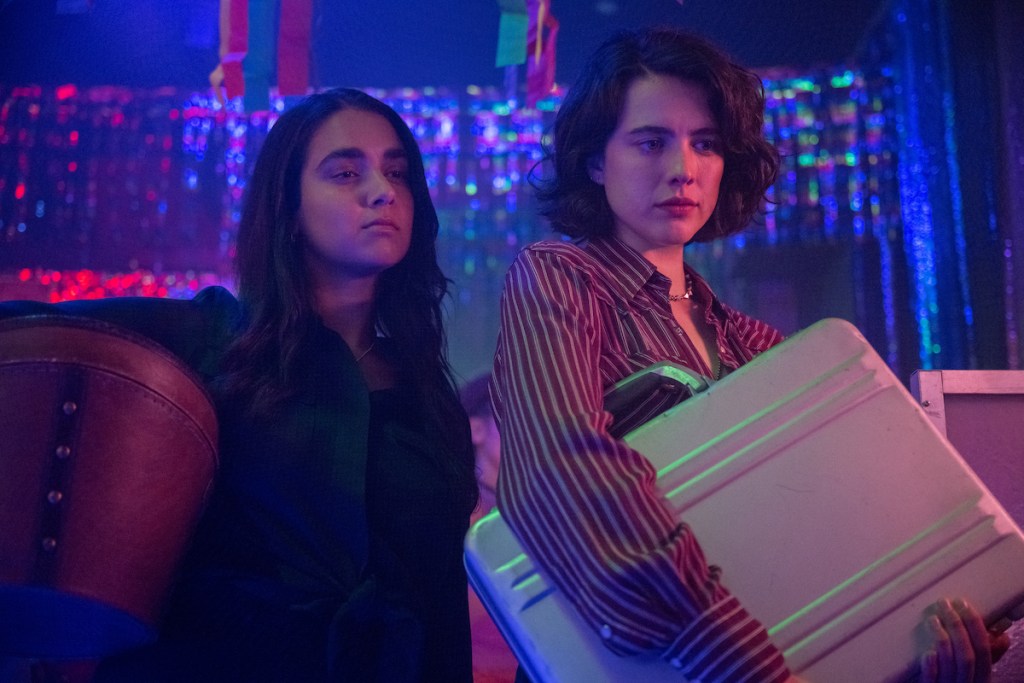
“Drive-Away Dolls” opens in a skeevy dive, the camera ominously pushing down the aisle between the bar and booths. Santos (Pedro Pascal) – paranoid, sweaty and clutching at a briefcase – peers around the corner, waiting. He’s supposed to meet someone, and they’re running late.
Spooked by a creepy encounter with a waiter, Santos hastily leaves the bar. Unfortunately for him, creepy waiter has other plans in mind. He corners Santos in an alleyway, smoke and shadows filling the screen while the camera sits at an uneasy tilt on both men. The waiter grabs the trash can lid Santos is using as a shield, prompting two dramatic gasps from the man before he’s unceremoniously stabbed in the neck with a corkscrew.
This opening promises everything that “Drive-Away Dolls” has in store – a delightful mix of noir and Looney Tunes absurdity. Directed by Ethan Coen (absent his brother Joel), the film brims with style at every turn – some of that style is classic Coens, some of it a little new. “Drive-Away Dolls,” from its composition to its content, is all about finding the ways new and old intersect and clash, delivering a good, old-fashioned road trip movie with twists and turns along the way.
Santos (God rest his soul) is only where our story begins. Fresh off a break-up with her girlfriend Sukie (Beanie Feldstein), Jamie (Margaret Qualley) is looking for a fresh start. She recruits her more prudish friend Marian (Geraldine Viswanathan) for a spontaneous road trip to Tallahassee, making plans for plenty of lesbian bars and debauchery along the way. But the duo become entwined in a bumbling criminal conspiracy when they find Santos’ briefcase in the trunk of their rental car.
“Drive-Away Dolls” has a madcap sort of flair, particularly when it comes to editing and acting. Qualley gives the broader of the two lead performances, a swaggering, Texas flirt who’s ready to make out with anyone at the drop of a hat. Her Texas accent can go overboard at times, but it slots right into the wacky nature of the film itself and never overtakes her wealth of natural charisma. Marian is the yin to Jamie’s yang – savvy where Jamie is artless, concerned where Jamie is carefree. By that same token, Viswanathan plays up her restraint opposed to Qualley’s forwardness. Her humor comes out at a clipped, matter-of-fact pace, her face stuck in a permanent, slight scowl at the brashness of those around her. But as the relationship between Jamie and Marian takes a more romantic turn, their vulnerabilities start to emerge – the sweet, sexy center to this crime caper.
“Drive-Away Dolls” has the eccentricity you would expect from a Coens movie, but with a slightly softer core. There are numerous interludes that punctuate the story, one in particular showing a young Marian jumping up and down in slow motion on a trampoline. From young Marian’s bright blue toenail polish to the dulcet tones of Linda Ronstadt’s “Blue Bayou” that underscore the moment, everything about this scene screams summer and innocence as Marian leaps into the air, hoping to catch a glimpse of the woman who lives next door as she sunbathes in the nude. This exuberant, youthful moment is marred by melancholy, however – the next time we see Marian on the trampoline, a man joins the woman outside. He doesn’t seem to care that the woman is naked, doesn’t seem to find her beautiful at all – just a faceless, beer-bellied reminder of the life Marian doesn’t want for herself.
Throughout the film, Coen and co-writer/editor Tricia Cooke put a lot of emphasis on these transitions, flipping between frames or spinning a scene out of the way to make way for another. There are a few psychedelic interludes featuring a 1970s hippie seductress that don’t fully gel until later on in the film, but even then, feel a little out of place visually in an otherwise 1990s world, pressing pause on the action for a little too long. What those interludes do accomplish, however, is furthering a theme of transition and division.
Whether it be Jamie and Marian’s journey to Tallahassee, their transition from friends to lovers, the political divides between generations, or the fact that Marian is constantly reading Henry James’ “The Europeans,” the meeting of an old and new way of life can be found all over “Drive-Away Dolls.” Coen and Cooke don’t necessarily seem too interested in diving very far into one aspect of this motif, but rather creating a kaleidoscope of transitory pieces, of old and new coming together to make a beautiful, if absurd, mosaic.
